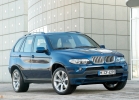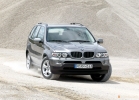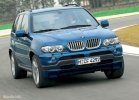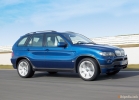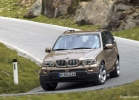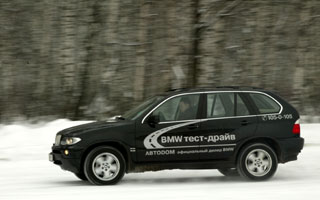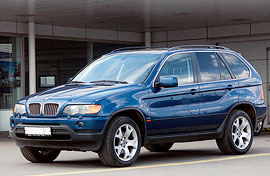Test drive BMW X5 E53 2003 - 2007 SUV
We go to the smell
BMW X5 3.0D. Price: from 67 500. On sale: March 2007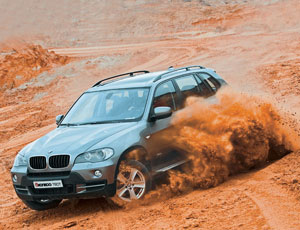 The diesel engines arrived in Russia on expensive cars. This means that dealers are least counting on a lean buyer. What can attract such a car except the smell of diesel exhausts? Squeeze our nose and get driving the new BMW X5 3.0D.
The diesel engines arrived in Russia on expensive cars. This means that dealers are least counting on a lean buyer. What can attract such a car except the smell of diesel exhausts? Squeeze our nose and get driving the new BMW X5 3.0D. The second generation of the most popular crossover, or rather, the car of the SAV class, BMW X5 received a new diesel in an in -line six with a capacity of 235 hp. with aluminum card. Regarding the gasoline version for modification with the 3.0D index, you will have to overpay 2500 euros. So does it make sense to buy such machines, given the dubious (on average in the country) quality of diesel fuel and more frequent rides for the service for planned technical inspections? And besides, these diesel engines are noisy, create vibrations, and it smells of them unpleasant. However, in this case, we are dealing with the product of the premium segment, therefore, according to the logic of things, the quality of exhaust gases should correspond to at least the pan-European level.
 So it happened. The BMW X5 3.0D quickly denied all diesel stereotypes, and in addition, it confirmed the thesis that over the past decade, the consumer characteristics of gasoline and diesel engines are close to giant pace. Let's start with vibrations. Some examples of motor design are really informed by the car body, and all sitting in the cabin, constant impulses, which is especially felt when the engine is idle. The X5 unit works very smoothly and the most important thing is quiet. Yes, bubbling, coming from the bowels of the engineering space, is really different from the usual gasoline tarrament. But on decibels this is completely not reflected.
So it happened. The BMW X5 3.0D quickly denied all diesel stereotypes, and in addition, it confirmed the thesis that over the past decade, the consumer characteristics of gasoline and diesel engines are close to giant pace. Let's start with vibrations. Some examples of motor design are really informed by the car body, and all sitting in the cabin, constant impulses, which is especially felt when the engine is idle. The X5 unit works very smoothly and the most important thing is quiet. Yes, bubbling, coming from the bowels of the engineering space, is really different from the usual gasoline tarrament. But on decibels this is completely not reflected. As for the sluggish behavior of this motor, the reluctance with which the offspring of old Rudolf spun was sprouted in the past, at least for BMW. Although this unit is not equipped with a boost according to the original Twin Turbo scheme, it still reacts quite sharply to the pressing of the gas pedal, and there is practically no turboyam. Power reserves are simply brutal. Let us take into account, in addition to the fact that the 6-speed automatic alternates the transfer almost imperceptibly, and even does this in the average speed range, when at the disposal of the driver of the regiment of a constant torque of 520 nm. It seems that it is possible to increase acceleration to infinity. Not every gasoline engine can compete with this quiet start! No wonder many firms are already exposing diesel engines.
 We add to this all the traditional advantages of the BMW: honed controllability, informative steering and a branding system of all -wheel drive XDRive, distributing the moment between the axes in dynamic mode. We get a multifunctional and dynamic car with moderate off -road properties. As for the more frequent visit to service stations, the transport of Munich production allows the owner to partly regulate this process himself. After all, the frequency with which the on -board computer gives a signal to leave for the next TO is not least dependent on the driving manner. But the practice of repairmen shows that the maintenance of machines with both types of motors occurs after the same time intervals. In addition, operating such a colossus, you can really save on fuel consumption. When the diesel engines become massive in our country, then we will consider the costs, and we recommend that people aiming at high -tech X5, we recommend using other, less rational criteria for choosing an engine.
We add to this all the traditional advantages of the BMW: honed controllability, informative steering and a branding system of all -wheel drive XDRive, distributing the moment between the axes in dynamic mode. We get a multifunctional and dynamic car with moderate off -road properties. As for the more frequent visit to service stations, the transport of Munich production allows the owner to partly regulate this process himself. After all, the frequency with which the on -board computer gives a signal to leave for the next TO is not least dependent on the driving manner. But the practice of repairmen shows that the maintenance of machines with both types of motors occurs after the same time intervals. In addition, operating such a colossus, you can really save on fuel consumption. When the diesel engines become massive in our country, then we will consider the costs, and we recommend that people aiming at high -tech X5, we recommend using other, less rational criteria for choosing an engine.  Instead of the heart
Instead of the heart At the recently held Engine of the Year competition, as many as four BMW engines were noted. And all, notice, gasoline. However, this does not mean that the 3-liter diesel diesel in a capacity of 173 kW (235 hp) under consideration is not worthy of attention. Although, at first glance, he really has nothing to boast of at all: just a good Munich motor with a torque of 520 Nm in the range from 2000 to 2750 min-1. And the turbocharging system on it is completely ordinary with a variable geometry of the guide apparatus, and the power system, although the third generation, but with the maximum pressure of only 1600 bar. But there is one small detail as usual today, from the ecological field. This is a neutralizer united in one case. This block is placed exactly next to the exhaust manifold in the engine compartment. Among other advantages, this provides a very fast (even with cold starting) neutralizer. Accordingly, at the stage of heating, when the usual diesel is especially smoking, this motor will pollute nature within normal.
Driving
In a sufficient extent informative and acute steering.
Salon
Quality materials. All information is read well, all functions work as it should.
Comfort
By and large, there is nothing to complain about. Noise insulation at a height, the suspension is a little harsh.
Safety
The previous generation had problems with the protection of pedestrians: there are only 1 star in the euro ncap tests, but the protection of passengers is at the highest level.
Price
The usual price order for the premium segment.
Brand and model of dimensions 4854/1933/1766 mm engine transmission dynamics Max 210 km/h; 8.3 C to 100 km/h competitors.
Technical characteristics BMW X5 3.0D
Dimensions, mm 4854/1933/1766
Diesel engine, 2993 cm3, 235 hp/4000 min-1
Automatic transmission, 6-speed
Dynamics 0-100 km/h, from 8.3
Maximum speed, km/h 210
Competitors Audi Q7, VW Touareg, Range Rover
Advantages and disadvantages
+ Traditional advantages BMW: excellent dynamics and handling, high level of comfort.
The disadvantages of such cars can be identified only by experiencing them according to special methods.
Our opinion
In large cities where there are no problems with fast and high -quality service and good diesel fuel, the demand for such machines is constantly growing. As for the shortcomings of the BMW X5 3.0D, there are not many of them. By and large, with the exception of the price that looks clearly high, and there is nothing to name.
Text: Sergey Arbuzov
Photo: Sergey Krestov
Source: Magazine 5 wheel [06/27/2007]
Video test drives BMW X5 E53 2003 - 2007
Video crash tests BMW X5 E53 2003 - 2007
Test drives BMW X5 E53 2003 - 2007
Crash test BMW X5 E53 2003 - 2007
Krassh Test: Detailed Information32%
Driver and passengers
2%
Pedestrians

